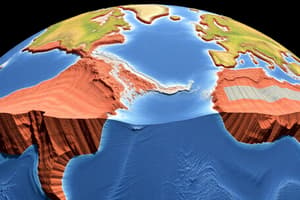Podcast
Questions and Answers
What geological phenomenon is caused by the collision between the Indian and Eurasian plates?
What geological phenomenon is caused by the collision between the Indian and Eurasian plates?
- Formation of volcanoes
- Mid Ocean Ridges
- Himalayan mountains grow taller (correct)
- Earthquakes in the ocean
Earthquakes occur primarily due to the sliding of tectonic plates.
Earthquakes occur primarily due to the sliding of tectonic plates.
True (A)
What happens when two continental plates collide?
What happens when two continental plates collide?
They crunch and fold the rock, leading to the formation of mountains.
At divergent boundaries, tectonic plates move apart, leading to the formation of __________.
At divergent boundaries, tectonic plates move apart, leading to the formation of __________.
Match the following geological phenomena with their causes:
Match the following geological phenomena with their causes:
What is the primary result of an oceanic-continental plate collision?
What is the primary result of an oceanic-continental plate collision?
The oceanic crust is generally thicker and less dense than the continental crust.
The oceanic crust is generally thicker and less dense than the continental crust.
Name an example of a volcanic island arc formed from oceanic-oceanic plate collisions.
Name an example of a volcanic island arc formed from oceanic-oceanic plate collisions.
When oceanic crust sinks beneath another plate, it creates a __________ zone.
When oceanic crust sinks beneath another plate, it creates a __________ zone.
Match the geological phenomena to their outcomes.
Match the geological phenomena to their outcomes.
What type of crust is forced beneath the other when an oceanic plate collides with a continental plate?
What type of crust is forced beneath the other when an oceanic plate collides with a continental plate?
Subduction zones are smooth processes devoid of any geological disturbances.
Subduction zones are smooth processes devoid of any geological disturbances.
What are the Himalayas a result of?
What are the Himalayas a result of?
What is the primary cause of the movement of tectonic plates?
What is the primary cause of the movement of tectonic plates?
Continental plates do not move significantly compared to oceanic plates.
Continental plates do not move significantly compared to oceanic plates.
What type of plate boundary occurs when two plates move away from each other?
What type of plate boundary occurs when two plates move away from each other?
The boundary where two tectonic plates slide past each other is called a __________ boundary.
The boundary where two tectonic plates slide past each other is called a __________ boundary.
Match the type of plate boundary with its characteristic example:
Match the type of plate boundary with its characteristic example:
Which of the following geological features is commonly formed by convergent boundaries?
Which of the following geological features is commonly formed by convergent boundaries?
Earthquakes and volcanoes are not commonly associated with plate boundaries.
Earthquakes and volcanoes are not commonly associated with plate boundaries.
Provide an example of a divergent boundary.
Provide an example of a divergent boundary.
The movement of magma in convection currents is primarily responsible for the __________ of tectonic plates.
The movement of magma in convection currents is primarily responsible for the __________ of tectonic plates.
What is a geological phenomenon formed due to the subduction of one tectonic plate beneath another?
What is a geological phenomenon formed due to the subduction of one tectonic plate beneath another?
Flashcards are hidden until you start studying
Study Notes
Plate Interaction
- Tectonic plates are constantly moving due to heat and pressure within the Earth, causing the hot magma to flow in convection currents.
Plate Boundaries
- Convergent Boundaries occur when two plates collide. An example is the boundary between the Eurasian Plate and the Indian Plate at the Himalayas.
- Divergent Boundaries occur when two tectonic plates move away from each other. An example is the boundary between the African Plate and the Arabian Plate in the Red Sea.
- Transform Boundaries are places where plates slide sideways past each other. An example is the boundary between the Pacific Plate and the Australian Plate, crossing New Zealand.
Continental vs Oceanic Plates
- Continental plates are generally lighter and less dense than oceanic plates.
- Oceanic plates are denser and thinner than continental plates.
Continental-Continental Collisions
- When two continental plates collide, the rock at the boundary is crunched and folded, leading to the formation of mountains and mountain ranges.
- The Himalayan range in southern Asia is an example of this type of collision.
- The Indian Plate continues its northward movement into Asia, causing the Himalayas to grow higher each year by 5 to 20 mm.
Continental-Oceanic Collisions
- When a continental plate collides with an oceanic plate, the denser oceanic crust gets subducted beneath the lighter and thicker continental crust.
- This forms a subduction zone, a deep oceanic trench/valley at the edge of the continent.
- The subduction process causes trapped water and other gases to be released, resulting in the formation of magma.
- The Ring of Fire, a band of active volcanoes encircling the Pacific Ocean, is an example of this type of collision.
Oceanic-Oceanic Collisions
- When two oceanic plates collide, the older plate is forced under the younger one, forming a subduction zone.
- This leads to the formation of volcanic island arcs, chains of volcanic islands.
- Examples of island arcs include the Mariana Islands in the western Pacific Ocean and the Aleutian Islands off the coast of Alaska.
- Large earthquakes and tsunamis can occur at subduction zones.
Subduction Zones
- Subduction zones are areas where one tectonic plate slides beneath another.
- They are generated when two oceanic plates collide or when a continental plate collides with an oceanic plate.
- Subduction zones are characterized by deep trenches, volcanic activity, and earthquakes.
Studying That Suits You
Use AI to generate personalized quizzes and flashcards to suit your learning preferences.




